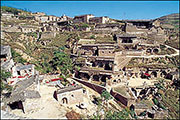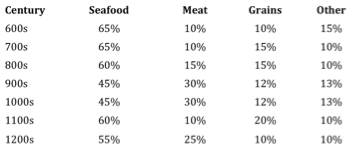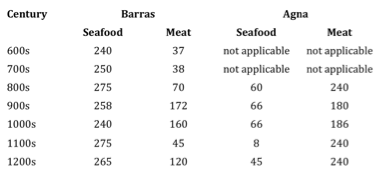-
Target Test Prep 20% Off Flash Sale is on! Code: FLASH20
Redeem
How to Read Multi-Source Reasoning Problems - Part 1
 Given that Integrated Reasoning may become more important for those who want to go into consulting or banking, lets take a look at a Multi-Source Reasoning (MSR) problem!
Given that Integrated Reasoning may become more important for those who want to go into consulting or banking, lets take a look at a Multi-Source Reasoning (MSR) problem!
In this first part, were going to take a look at how to read and take notes on the MSR text. In the next article, well do a problem that goes with the text. This MSR is from the free GMATPrep test, so if you have not yet taken GMATPrep, dont read this article yet! Put it away and come back to it after youve seen the problem yourself.
MSRs appear as three tabs of information. I cant format things into tabs here, so Ill just show it all to you one after the other. You have about 2.5 minutes per question on IR. This MSR has a total of 3 associated questions, but Im only giving you one in this article. Spend about 2 to 2.5 minutes on the read-through, leaving yourself about 1.5 to 2 minutes to spend on each question.
Tab 1
An archaeological team has been excavating three ancient village sitesBarras, Agna, and Cussaialooking in particular at kitchen waste dumps as a way to understand the villages dietary patterns and trading relationships. What follows are brief summaries of their findings.Barras: The best data come from stratified finds in this oceanside village, which was inhabited from AD 600 to 1300 and was the only one of the three villages to produce seafood, its main dietary item. Though Barras residents hunted on land and raised crops, this provided relatively small amounts of food. As Barrass overall prosperity rose, there was more food available per person, and its population increased from an average of 100 residents in the AD 600s to 400 residents in the AD 1000s to 600 residents in the AD 1200s.
Agna: Agna was established in an inland forest around AD 800 and its residents mainly hunted but also ate considerable amounts of fruit, nuts, and other forest-vegetable products. They also traded meat to Barras for other goods. With no open fields, Agna grew no grain.
Cussaia: Predating Barras, Cussaia depended heavily on raising grain crops and eventually obtained seafood and meat via trade. It traded directly only with Barras, because a mountain range separated it from Agna, though some products may have been traded between Agna and Cussaia via Barras.
Additionally, there is no evidence that any other village traded with Barras, Agna, or Cussaia prior to AD 1300.
--
Tab 2
Barras: Percentages, by Estimated Weight, of Dietary Items Consumed per Person per Month
--
Tab 3
Barras, Agna: Estimated Average Monthly Meat and Seafood Consumption (lb per 4-Person Family)
--
Thats a lot to read through in only 2 minutes or so. The key is to be able to divide the info into three categories:
- Important and I need to understand right now
- Important but I can come back to it later, when Im doing the questions
- Not that important (but I can still come back if necessary)
How can you possibly know what likely will and will not be important? There are some good clues; your job is to learn how to use them.
The first tab will almost always contain text providing the main storyline. The second and third tabs may contain additional text, or charts or graphs, or some combination of the two.
In general, its a good idea to look through the tabs in order. As expected, the first tab does provide the background for the whole story, so dive in.
The opening sentence indicates the key focus: the archaeologists used kitchen waste dumps to understand dietary patterns and trading relationships. Great! Jot down info about dietary patterns and trading relationships; pay less attention to other info.
Hmm. Barras, Agna, and Cussaia each have their own paragraphs. First, abbreviate using the letters B, A, and C. Second, these paragraphs contain quite a bit of information, but dont bother to note down that the best data came from B or that it was an oceanside village. Dont note that A was an inland forest. Why? These dont directly address the dietary patterns or trading relationships. Note that B did experience a population increase, but ignore the details; you can go back for them later if you need them.
You can also ignore the last sentence of the first tab (there is no evidence that any other village traded with B, A, or C prior to AD 1300). Its there just to let us know that we can disregard the idea that some other culture or village might have affected trade. This is the equivalent, on a math problem, of giving 1/x and saying that x does not equal zero.
One good set of notes for this MSR might look something like this (everyones notes will be a bit different, of course):
T1
B: Seafood. Some hunt, crops. Pop >>.
A: Hunt and gather. Trade meat w/B. No grain.
C: Grain. Got fish, meat via trade with B.
T2: B % food type per month by century
T3: B, A: meat, fish lb eaten per 4-people by century
Obviously, were not going to write out the data from the 2nd and 3rd tabs; just note what kind of information is found in each tab.
Okay, are you ready to try a problem? Ill tell you what: Ill give you one here, but Im not going to give you the solution or explanation until the second part of the article. You can go look up the solution, of course. If you run into trouble, though, I encourage you to spend some time wrestling with it and trying to figure it out yourself. Youll learn a lot more in the end.
Here you go. Give yourself about 1.5 minutes to answer.
Based on the information in the passage and tables, it can be determined that the average monthly meat consumption, in pounds, by the residents of Barras in the AD 1000s was which of the following?(A) 9,600
(B) 10,000
(C) 16,000
(D) 17,400
(E) 18,000
Check back next time for the solution and a discussion of the problem. (I might also give you a second problem for this same MSR)
Key Takeaways for Reading MSR Problems
(1) The first tab is going to set context for you, but its also going to include a lot of unnecessary information. How to know whats important? Pay attention to the first few sentences, which will tell you the theme of the coming information. Take notes on anything that fits that key theme and ignore the rest.
(2) Dont write down numbers! Write down what the numbers represent and where to find them again. For example, note that the B paragraph in tab 1 gives data on population increases. Note the kind of information contained in the tables in tabs 2 and 3.
(3) Expect to spend about 2 to 2.5 minutes overall on your initial read-through of the tabs. That will leave you with about 1.5 to 2 minutes per question (most MSRs have a total of 3 questions).
* GMATPrep questions courtesy of the Graduate Management Admissions Council. Usage of this question does not imply endorsement by GMAC.
Recent Articles
Archive
- April 2024
- March 2024
- February 2024
- January 2024
- December 2023
- November 2023
- October 2023
- September 2023
- July 2023
- June 2023
- May 2023
- April 2023
- March 2023
- February 2023
- January 2023
- December 2022
- November 2022
- October 2022
- September 2022
- August 2022
- July 2022
- June 2022
- May 2022
- April 2022
- March 2022
- February 2022
- January 2022
- December 2021
- November 2021
- October 2021
- September 2021
- August 2021
- July 2021
- June 2021
- May 2021
- April 2021
- March 2021
- February 2021
- January 2021
- December 2020
- November 2020
- October 2020
- September 2020
- August 2020
- July 2020
- June 2020
- May 2020
- April 2020
- March 2020
- February 2020
- January 2020
- December 2019
- November 2019
- October 2019
- September 2019
- August 2019
- July 2019
- June 2019
- May 2019
- April 2019
- March 2019
- February 2019
- January 2019
- December 2018
- November 2018
- October 2018
- September 2018
- August 2018
- July 2018
- June 2018
- May 2018
- April 2018
- March 2018
- February 2018
- January 2018
- December 2017
- November 2017
- October 2017
- September 2017
- August 2017
- July 2017
- June 2017
- May 2017
- April 2017
- March 2017
- February 2017
- January 2017
- December 2016
- November 2016
- October 2016
- September 2016
- August 2016
- July 2016
- June 2016
- May 2016
- April 2016
- March 2016
- February 2016
- January 2016
- December 2015
- November 2015
- October 2015
- September 2015
- August 2015
- July 2015
- June 2015
- May 2015
- April 2015
- March 2015
- February 2015
- January 2015
- December 2014
- November 2014
- October 2014
- September 2014
- August 2014
- July 2014
- June 2014
- May 2014
- April 2014
- March 2014
- February 2014
- January 2014
- December 2013
- November 2013
- October 2013
- September 2013
- August 2013
- July 2013
- June 2013
- May 2013
- April 2013
- March 2013
- February 2013
- January 2013
- December 2012
- November 2012
- October 2012
- September 2012
- August 2012
- July 2012
- June 2012
- May 2012
- April 2012
- March 2012
- February 2012
- January 2012
- December 2011
- November 2011
- October 2011
- September 2011
- August 2011
- July 2011
- June 2011
- May 2011
- April 2011
- March 2011
- February 2011
- January 2011
- December 2010
- November 2010
- October 2010
- September 2010
- August 2010
- July 2010
- June 2010
- May 2010
- April 2010
- March 2010
- February 2010
- January 2010
- December 2009
- November 2009
- October 2009
- September 2009
- August 2009

